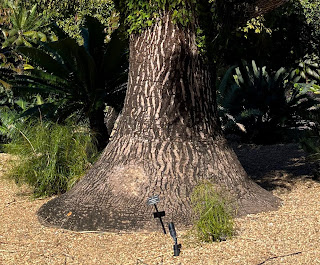Root flare is a sign of health in trees, but I'd never seen the likes of this. I'm calling it a kapok tree (Ceiba pentandra) after encountering this charming video that describes its buttressed base and the fluffy seeds that used to provide stuffing for life vests.
The extravagant buttressing is reminiscent of the fins of a rocket that in this case can reach more than 200 feet tall, vaulting above the rainforest canopy. With seedpods packed with useful fiber, it's not surprising that the kapok is in the same plant family as cotton--the Malvaceae, also known as the mallow family.
One of Princeton's native members of that family is the rose mallow hibiscus (Hibiscus moscheutos), fairly common along the shores of Lake Carnegie and in raingardens.
The ombu, a native to the Argentine pampas that goes by the latin name Phytolacca dioica, develops a conspicuously bloated base that with time can become convenient for sitting. If you haven't seen one, just imagine a 50 foot high pokeweed--our local Phytolacca americana with very similar leaves, flowers, and berries.
The ombu, a native to the Argentine pampas that goes by the latin name Phytolacca dioica, develops a conspicuously bloated base that with time can become convenient for sitting. If you haven't seen one, just imagine a 50 foot high pokeweed--our local Phytolacca americana with very similar leaves, flowers, and berries.











Moreton Bay Fig (Moraceae) displays similar root buttressing, but somewhat flatter, more disorganized directionally, and usually with basal multi-trunking (but none of ceiba's thorns!). And Quararibea asterolepis (Bombacaceae) in Panama, with fairly small buttress roots, displays intriguing trunk shape to match the roots -- square cross-section, sometimes. Roots have many roles!
ReplyDeleteCool stuff.
Delete